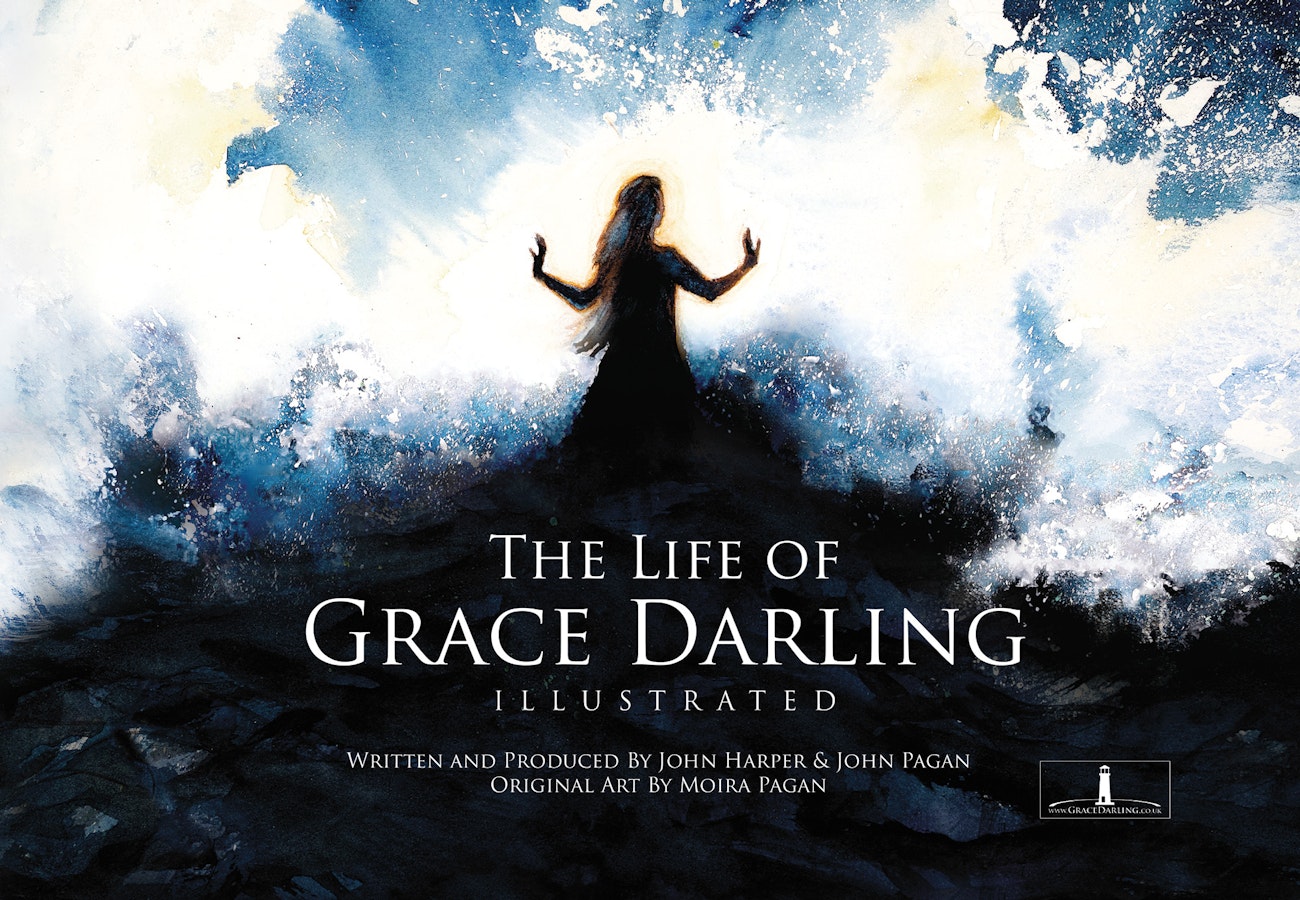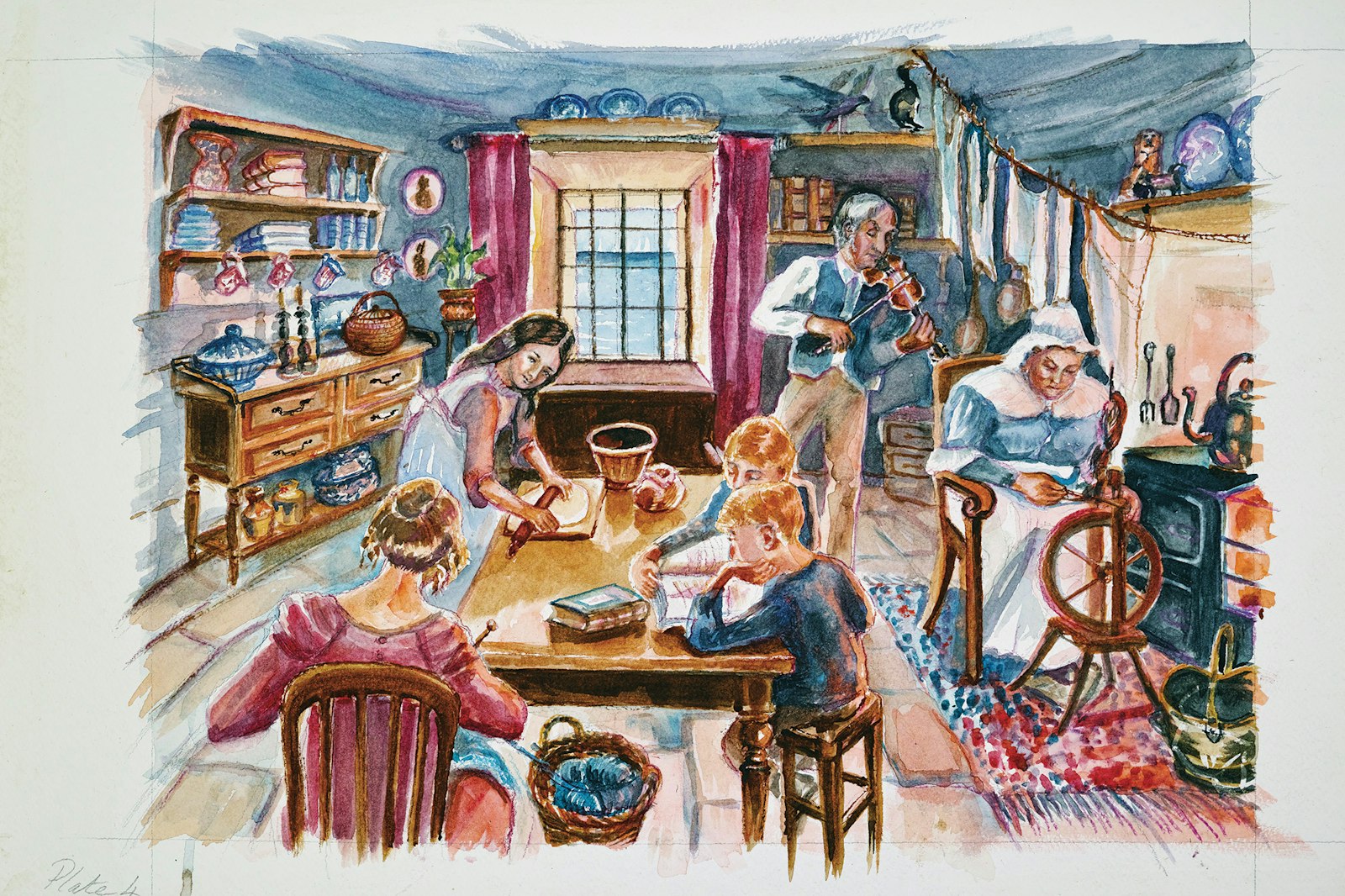The following is adapted with permission from The Life of Grace Darling, published in 2016 by The Grace Darling Website and can be found in the Fall 2019 issue of PieceWork.
William Darling was the resident lighthouse keeper at Brownsman Island, one of the Farne Islands, and he lived there with his family three miles out to sea. His wife, Thomasin, decided to stay with her own parents in nearby Barnburgh for the birth of their seventh child. On November 24, 1815, Grace Horsley Darling came into the world.
By the mid-1820s, William had been the lighthouse keeper at Brownsman for ten years, and he saw the urgent need for a new lighthouse at the very edge of the Farnes. The authorities agreed and chose Longstone Rock as the site for a permanent lighthouse.
The move to Longstone took place in January 1826, when Grace was ten. This barren, lonely rock, barely two meters [6 ft] above sea level at high tide, became the Darling’s family home.
The SS Forfarshire was a paddle steamship with luxury accommodation. She was built as a seagoing vessel in 1834 by Thomas Adamson of Dundee for the Dundee and Hull Steam Packet Company to travel the North Sea between these two cities. With around forty passengers and twenty-two crew on board, the steamship Forfarshire sailed from Hull at 6:30 p.m. on Wednesday, September 5, 1838, reaching the open sea at Spurn Point in around three hours. Problems with the ship’s boilers were apparent when the Forfarshire had sailed from Dundee a few days earlier, but the repairs made at Hull docks satisfied Captain Humble that all was well.
During the early evening, the vessel passed the Farne Islands close to the coast of Northumberland. However, engine problems persisted and the wind now increased, the sea became rough, and the captain was forced to raise some sails to compensate. At 1:00 a.m. on Friday, September 7, off St Abbs Head, Captain Humble made the decision to turn back and seek shelter.
The storm was relentless. The dark night, the high seas, and the lashing rain made it extremely difficult to navigate. The engines had failed. The sails were still set, but the ship’s large paddle boxes were a hindrance in such conditions. Captain Humble anxiously scanned the dark horizon. He knew they must be approaching the Farne Islands soon. Then, finally, off her port side he saw a flash from the Inner Farne Lighthouse.
 The Forfarshire wrecks on Harcar Rock. Illustration by and © Moira Pagan
The Forfarshire wrecks on Harcar Rock. Illustration by and © Moira Pagan
Unfortunately, the captain had made a grave miscalculation; the light he had just seen was actually from Longstone, further out to sea, surrounded by many dangerous rocks. Sharp, jagged edges ripped into the ship’s bow, which stuck fast to the rock and trapped her, while the sea repeatedly broke over the body of the ship, causing devastation. The Forfarshire was lifted by the sea and struck the rock again, this time splitting her in two by the paddle wheels. The front section remained stuck to the rock, and the fierce sea soon engulfed the broken ship and flooded down the stairways, where terrified passengers drowned in their cabins. Many who made it onto the deck, crew and passengers alike, were quickly swept overboard.
High up inside the lantern of Longstone Light, William Darling kept watch through the night as the gathering storm surrounded the whole of the Farnes. An irresistible urge compelled Grace to look from her window. It was almost 5:00 a.m. As her eyes adjusted to the dark void, she was shocked to see a large, black shape lodged on the distant rocks. She held her breath, and nervously reached for her telescope. Through the glass she saw the bulky outline of a ship, motionless. From her bedroom window, Grace focused the glass, patiently watching for signs of life, barely looking away for a moment. Then at 7:00 a.m., Grace spotted people on the distant rock. Through the hazy light she could see three or four people. There were survivors!
Grace rushed to tell her father what she had seen and insisted they make ready the coble to attempt a rescue. William hesitated. Longstone was only about a mile from the wreck, but he was without his son to assist him. William could not go out alone. Grace pleaded passionately with her father that they go out together, determined to take the place of her absent brother. Together, they quickly prepared themselves to face the elements.

William helps the survivors while Grace keeps the coble off the rocks. Illustration by and © Moira Pagan
On the rock of Big Harcar, survivors gathered, desperate to be saved. William had expected to find four or five to bring back to the lighthouse. However, as they arrived they could see twice that number clinging to the rocks for dear life. William’s heart sank as he realized that a second trip to the wreck would be inevitable.
On the mainland, it was feared all had perished in the Forfarshire wreck until, some days later, word of an amazing rescue by the Darlings began to circulate. One of the rescued men wept as he described how a young woman in a rowing boat came to save them as they clung on for life to rocks in stormy seas.
Within days The Times published the account and Londoners were reading full details of the violent storm, the tragic fate of the Forfarshire and dreadful loss of life, but how, against all odds, nine souls from the wreck had been saved through the efforts of a lighthouse keeper’s daughter.
 The story hits the London newspapers. Grace is declared a national heroine. Illustration by and © Moira Pagan
The story hits the London newspapers. Grace is declared a national heroine. Illustration by and © Moira Pagan
Fuelled by the publicity, her fame swept the nation. Grace was under pressure from all sides to leave home and show herself to the outside world where she would receive great acclaim. But she had no wish to leave the lighthouse; its familiar walls offered the only protection from a demanding and intrusive world. She longed to return to her everyday normal life at home. However, her new-found celebrity would not allow this, and the pressure took its toll.
The eldest Darling son, William, was now the official lighthouse keeper at Coquet Island, and in March 1842 it was arranged for Grace and sister Thomasin to visit for a few days. The seclusion of Coquet Island was a welcome change. Grace enjoyed her stay with her brother, but she caught a chill on the chest and soon after returning to Longstone she began to fall ill.
At 8:15 p.m. on Thursday, October 20, 1842, Grace asked to be raised from her pillow, and she died in her father’s arms. She was twenty-six years old. Cause of death was recorded as tuberculosis.

Also, remember that if you are an active subscriber to PieceWork magazine, you have unlimited access to previous issues, including Fall 2019. See our help center for the step-by-step process on how to access them.
The Grace Darling Website
For additional information on Grace Darling, the book The Life of Grace Darling, and its authors and illustrator, visit www.gracedarling.co.uk. The website contains portraits of Grace, her mother and father; paintings depicting the rescue; a map of the Farne Islands in the North Sea; and a trove of Grace Darling memorabilia. A Kindle edition of the book is available from Amazon in the United States; Kindle and print editions are available from Amazon in the United Kingdom.
Authors John Pagan and John Harper are cofounders and coproducers of The Grace Darling Website. Illustrator Moira Pagan trained at Saint Martin’s School of Art, Ravensbourne College of Art, and Goldsmiths College. The paternal grandmother of Moira and her brother John Pagan was Agnes Darling Bell, a relative of Grace Darling.
Originally published November 22, 2019; updated June 29, 2022.

